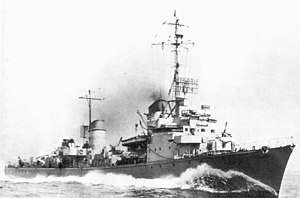
Back Torpédovka typu 1939 Czech Flottentorpedoboot 1939 German Classe Type 1939 French Classe 1939 Italian T22型水雷艇 Japanese Torpedowce typu 1939 Polish Миноносцы типа 1939 Russian Міноносці типу 1939 Ukrainian
 T-35 in US service, August 1945
| |
| Class overview | |
|---|---|
| Name | Type 39 |
| Builders | Schichau, Elbing |
| Operators | |
| Preceded by | Type 37 torpedo boat |
| Succeeded by | Type 40 torpedo boat |
| Built | 1940–1944 |
| In commission | 1941–1955 |
| Planned | 39 |
| Completed | 15 |
| Cancelled | 24 |
| Lost | 11 |
| General characteristics (T22 as built) | |
| Type | Torpedo boat |
| Displacement | 1,294 t (1,274 long tons) (standard) |
| Length | 102.5 m (336 ft 3 in) o/a |
| Beam | 10 m (32 ft 10 in) |
| Draft | 3.22 m (10 ft 7 in) |
| Installed power |
|
| Propulsion |
|
| Speed | 33.5 knots (62.0 km/h; 38.6 mph) |
| Range | 2,400 nmi (4,400 km; 2,800 mi) at 19 knots (35 km/h; 22 mph) |
| Complement | 206 |
| Sensors and processing systems |
|
| Armament |
|
The Type 1939 torpedo boats, also known as the Elbing class by the Allies, were a group of 15 torpedo boats that were built for Nazi Germany's Kriegsmarine during World War II.
The first eight ships to be completed were sent to western France in pairs after they finished working up from late 1942 through the beginning of 1944. They were tasked to escort convoys, blockade runners and submarines through the English Channel and the Bay of Biscay. The ships also laid minefields. Not long after the first pair arrived, they sank a British cruiser and an escort destroyer without loss or damage to themselves in the Battle of Sept-Îles in October 1942. Over a year later, two ships were sunk by British cruisers in the Battle of the Bay of Biscay in December 1943. During the action of 26 April 1944 and subsequent operations, Allied forces intercepted three Type 39s of which two were lost, although they sank a Canadian destroyer in exchange. Of the two remaining ships based in France when the Allies invaded Normandy (Operation Neptune) on 6 June, one ship helped to sink a Norwegian destroyer before escaping to Germany and the other was sunk by fighter-bombers in August.
All of the remaining Type 39s were committed to the Baltic Sea from April 1944, where they escorted convoys, laid mines and provided naval gunfire support to Axis forces and operations. One ship was sunk by the Soviets while supporting Finnish operations in the Gulf of Finland in June, three were sunk in August when they accidentally entered an existing German minefield when they were attempting to lay a new one, and another sank after hitting a mine during gunnery training in November. The Type 39s began bombarding Soviet positions in October during the Soviet Moonsund Landing Operation as the Germans began evacuating the islands off the west coast of Estonia, and they continued to do so for the rest of the war, often in conjunction with cruisers. In May, with the collapse of Germany imminent, their role changed to evacuating people from areas that were threatened by the advancing Soviets, and they helped to rescue hundreds of thousands before the German surrender. One ship was lost to Soviet aircraft during this time.
Four Type 39s survived the war and were seized by the Allies as war reparations. The United States Navy briefly evaluated one before turning it over to the French in 1947 as spares for their pair that the French Navy kept in service until 1954–1955. The Soviet Union used their ship until about the same time before scrapping it in 1956.
© MMXXIII Rich X Search. We shall prevail. All rights reserved. Rich X Search